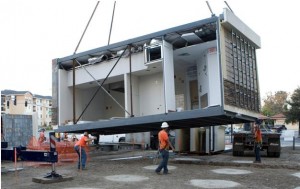
The benefits of using prefabricated components in construction are many, although utilizing such components does offer its own challenges as well. This growing trend of developing using prefab architecture is one that many suggest will be the future of construction.
The Use of Prefab Components as the Future of Construction
Imagine using prefabricated and manufactured building components to reduce the total time needed to build a 57-story building to under three weeks. Unfathomable right? Not so fast! This timeline was the reality for the construction of a building by China’s Broad Sustainable Building (BSB) company in 2015. The advent of newer technologies, such as 3D printing and additive manufacturing has advanced the use of prefabricated components as a standard in the construction of modern structures.
Additionally, after the “Great Recession” of 2009 resulted in the loss of millions of construction architecture jobs, a skills gap emerged as the construction industry bounces back. Today’s youth are increasingly opting for professions in technology and elsewhere rather than learning the skills of traditional tradesmen and construction workers. By using prefab components, construction projects can be completed with far less reliance on skilled workers as much of the complex assembly is done in off-site manufacturing facilities.
Issues Related to Reliance on Manufactured Components
The efficiencies in productivity and cost-savings enjoyed through the use of prefabricated and manufactured components are somewhat offset by the newness of this burgeoning technology. For example, the Atlantic Yards Complex in New York City, a development complex of high rise residential units, was shut down in 2014 due to the inability of the developer to meet the demand for the prefabricated/manufactured components necessary for the project. The relative newness of the technology has led to demand that has exceeded the capabilities of prefab building component manufacturers. Cost overruns have led to a rancorous discourse between developers, manufacturers and end-users.
Bridging the Gap Between Capability and Results
When the use of prefabricated materials in the construction of certain building projects is successful, such as in high rise buildings, it astonishes and amazes those who are witness to the process. The manufactured building components involved in the development of BSB’s 57-story building in China embody a safer, more innovative, and revolutionary approach to meeting the demands for new residential housing and commercial venues in many areas of the world.
Given the confluence of factors, ranging from time and cost requirements, to reduced waste, to the existing skills gap in the construction industry, prefab architecture and building appears to here to stay.
[/vc_column_text][/vc_column][/vc_row]

